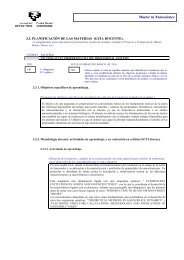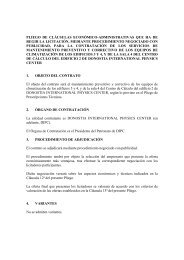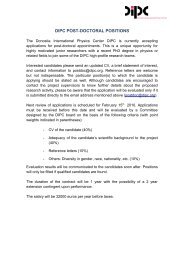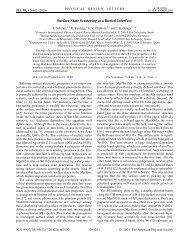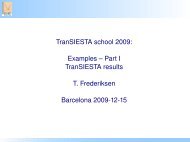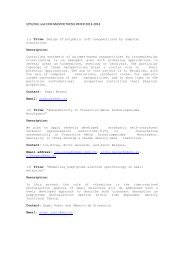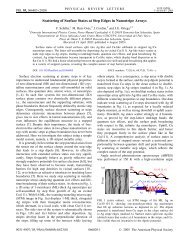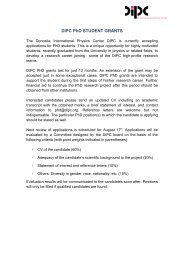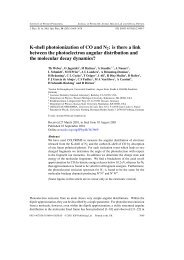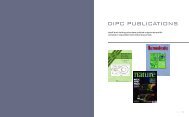Flocculation in Carbon Black Filled Rubber ... - All-electronics.de
Flocculation in Carbon Black Filled Rubber ... - All-electronics.de
Flocculation in Carbon Black Filled Rubber ... - All-electronics.de
Create successful ePaper yourself
Turn your PDF publications into a flip-book with our unique Google optimized e-Paper software.
<strong>Flocculation</strong> <strong>in</strong> <strong>Carbon</strong> <strong>Black</strong> <strong>Filled</strong> <strong>Rubber</strong> Compounds<br />
Table 4. High frequency viscoelasticity data obta<strong>in</strong>ed for rubber compounds before and<br />
after 24 hours ag<strong>in</strong>g at 80 8C. Compounds were prepared with Sn-SSBR and 50 phr N330<br />
Sample No. Sample Treatment Longitud<strong>in</strong>al Attenuation<br />
Coefficient, a L<br />
[mm 1 ]<br />
1 Before Ag<strong>in</strong>g 0.214<br />
2 After 24 hours ag<strong>in</strong>g at 80 8C 0.246<br />
<strong>in</strong> diameter and variable thickness <strong>in</strong> or<strong>de</strong>r<br />
to apply the Beer law to calculate<br />
the attenuation coefficient. The measurements<br />
presented <strong>in</strong> Table 4 <strong>in</strong>dicate that<br />
the attenuation coefficient <strong>in</strong>creases for<br />
aged rubber samples. Thermal ag<strong>in</strong>g<br />
leads to <strong>in</strong>creased polymer/filler <strong>in</strong>teractions<br />
and <strong>in</strong>creased flocculation. The aggregates<br />
that don't belong orig<strong>in</strong>ally to<br />
percolated cluster will contribute the<br />
most to this effect.<br />
Increased polymer/filler <strong>in</strong>teractions<br />
should also be manifested by an <strong>in</strong>creased<br />
amount of bound rubber. Based<br />
on the previous work [5], it was expected<br />
that the amount of bound rubber would<br />
<strong>in</strong>crease with <strong>in</strong>creas<strong>in</strong>g mix<strong>in</strong>g time<br />
and <strong>in</strong>creas<strong>in</strong>g ag<strong>in</strong>g temperature. The<br />
experimental results will be presented <strong>in</strong><br />
the follow<strong>in</strong>g paragraph.<br />
Uncured rubber compounds bound<br />
rubber<br />
It was discovered dur<strong>in</strong>g the course of this<br />
study that the amount of bound rubber<br />
correlates well with the flocculation <strong>in</strong>tensity.<br />
The data presented <strong>in</strong> Figs. 6 and 7<br />
show that the higher the amount of bound<br />
rubber, observed for the compounds prepared<br />
with Sn-SSBR, the higher the flocculation<br />
<strong>in</strong>tensity. In addition, the bound<br />
rubber <strong>in</strong>creases with <strong>in</strong>creas<strong>in</strong>g ag<strong>in</strong>g<br />
temperature, similarly to the flocculation<br />
<strong>in</strong>tensity. Bound rubber measurements<br />
can provi<strong>de</strong> very useful <strong>in</strong>formations<br />
about the filler network <strong>de</strong>nsity. As can<br />
be seen from Fig. 8, the toluene extract<br />
is clear or black <strong>de</strong>pend<strong>in</strong>g on the carbon<br />
black load<strong>in</strong>g and the thermal ag<strong>in</strong>g history.<br />
From the TEM picture of the unaged<br />
rubber compound loa<strong>de</strong>d with carbon<br />
black around percolation level one could<br />
easily i<strong>de</strong>ntify the ªlooseº aggregates that<br />
will be extracted by toluene from the compound<br />
caus<strong>in</strong>g the dark color of the extract.<br />
These aggregates participate <strong>in</strong><br />
polymer-filler <strong>in</strong>teractions, however, they<br />
are not a part of a large conduct<strong>in</strong>g cluster.<br />
The ag<strong>in</strong>g <strong>de</strong>nsifies the <strong>in</strong>terpenetrated<br />
carbon black/polymer networks<br />
<strong>in</strong> such a way that previously ªlooseº aggregates<br />
becomes a part of the network<br />
as manifested <strong>in</strong> Fig. 9 where the transparency<br />
of the toluene extract was evaluated.<br />
Before the ag<strong>in</strong>g process, the<br />
ªlooseº aggregates can be i<strong>de</strong>ntified<br />
even for the compounds above percolation<br />
threshold. The ag<strong>in</strong>g practically elim<strong>in</strong>ates<br />
ªlooseº aggregates. This also could<br />
be observed for the compound around<br />
percolation threshold. Also very <strong>in</strong>terest<strong>in</strong>g<br />
is the mix<strong>in</strong>g time <strong>de</strong>pen<strong>de</strong>nce for<br />
compounds loa<strong>de</strong>d with 50 phr N115.<br />
At the beg<strong>in</strong>n<strong>in</strong>g, when the dispersion is<br />
very poor, the carbon black network is<br />
very <strong>de</strong>nse. Later, with <strong>in</strong>creas<strong>in</strong>g mix<strong>in</strong>g<br />
time the color of toluene extract become<br />
darker <strong>in</strong>dicat<strong>in</strong>g that some aggregates<br />
are extracted by the solvent. Further mix<strong>in</strong>g,<br />
m<strong>in</strong>imize the amount of ªlooseº aggregates<br />
as <strong>in</strong>dicated by the lighter color<br />
of the extract. These results are consistent<br />
with the resistivity and dynamic properties<br />
measurements.<br />
Uncured rubber compounds low<br />
stra<strong>in</strong>, low frequency dynamic<br />
measurements<br />
Dynamic measurements are relatively difficult<br />
to perform on uncured compounds.<br />
Dur<strong>in</strong>g the course of these experiments,<br />
the samples were aged <strong>in</strong> the uncured<br />
stage. Next, the compounds were cured<br />
us<strong>in</strong>g electron beam radiation at the<br />
Bridgestone/Firestone research facility <strong>in</strong><br />
Akron, Ohio. This is a low temperature process<br />
so the samples rema<strong>in</strong> at room temperature<br />
all the time. In or<strong>de</strong>r to be cured by<br />
the electron beam procedure, the sample<br />
does not have to conta<strong>in</strong> the conventional<br />
sulfur-cur<strong>in</strong>g package. An example of the<br />
data obta<strong>in</strong>ed dur<strong>in</strong>g these measurements<br />
is presented <strong>in</strong> Fig. 10. The storage shear<br />
modulus G 0 MAX <strong>in</strong>creases after thermal<br />
ag<strong>in</strong>g for each sample un<strong>de</strong>r <strong>in</strong>vestigation<br />
<strong>in</strong>dicat<strong>in</strong>g that the additional connections<br />
between carbon black aggregates were<br />
created dur<strong>in</strong>g the ag<strong>in</strong>g process.<br />
Dur<strong>in</strong>g cur<strong>in</strong>g behavior electrical<br />
measurements<br />
<strong>All</strong> the above examples used rubber compounds<br />
prepared without curatives; <strong>in</strong> the<br />
follow<strong>in</strong>g examples the compounds with<br />
curatives will be consi<strong>de</strong>red. Usually,<br />
mixed rubber sample will conta<strong>in</strong> the<br />
curative package and will be vulcanized<br />
at elevated temperatures <strong>in</strong> or<strong>de</strong>r to<br />
form the f<strong>in</strong>al product. Dur<strong>in</strong>g the vulcanization<br />
process, the temperature <strong>in</strong>duced<br />
motions of both polymer and carbon<br />
black networks lead to a new configuration<br />
result<strong>in</strong>g <strong>in</strong> reduction of the rubber<br />
compound resistivity. Data presented <strong>in</strong><br />
Table 5 show that <strong>in</strong><strong>de</strong>ed the volume resistivity<br />
<strong>de</strong>creases with <strong>in</strong>creas<strong>in</strong>g <strong>de</strong>gree<br />
of vulcanization.<br />
Cured compounds electrical<br />
measurements<br />
<strong>Flocculation</strong> could be also observed <strong>in</strong><br />
cured rubber compounds. However, the<br />
effect is significantly smaller than <strong>in</strong> uncured<br />
compounds. The crossl<strong>in</strong>k<strong>in</strong>g reduces<br />
significantly the mobility of polymer<br />
cha<strong>in</strong>s and blocks carbon black aggregates<br />
<strong>in</strong> position. A simple experiment<br />
was conducted, where the polymer<br />
crossl<strong>in</strong>k<strong>in</strong>g <strong>de</strong>nsity was controlled by different<br />
sulfur content <strong>in</strong> the sample. The<br />
flocculation <strong>in</strong>tensity and the flocculation<br />
rate <strong>de</strong>crease with <strong>in</strong>creas<strong>in</strong>g sulfur content<br />
(see Fig. 11). The changes observed<br />
<strong>in</strong> this experiments are small, however<br />
significant. It is important to note that<br />
Table 5. Volume resistivity obta<strong>in</strong>ed for the<br />
rubber compounds at different cross-l<strong>in</strong>k<br />
<strong>de</strong>nsities. Compound: Dura<strong>de</strong>ne 706,<br />
30 phr N220. Cur<strong>in</strong>g temperature: 138 8C.<br />
t 90 ˆ 65 m<strong>in</strong><br />
Sample<br />
No.<br />
Cur<strong>in</strong>g<br />
Time<br />
[m<strong>in</strong>.]<br />
Volume Resistivity<br />
[Xcm]<br />
1 0 2.71 10 9<br />
2 15 2.10 10 9<br />
3 30 6.82 10 7<br />
4 35 3.40 10 6<br />
5 40 6.87 10 5<br />
6 45 5.24 10 4<br />
7 50 4.51 10 4<br />
8 55 4.20 10 4<br />
9 60 2.67 10 4<br />
10 65 2.37 10 4<br />
11 80 2.49 10 4<br />
12 110 2.64 10 4<br />
KGK Kautschuk Gummi Kunststoffe 55. Jahrgang, Nr. 11/2002 601



